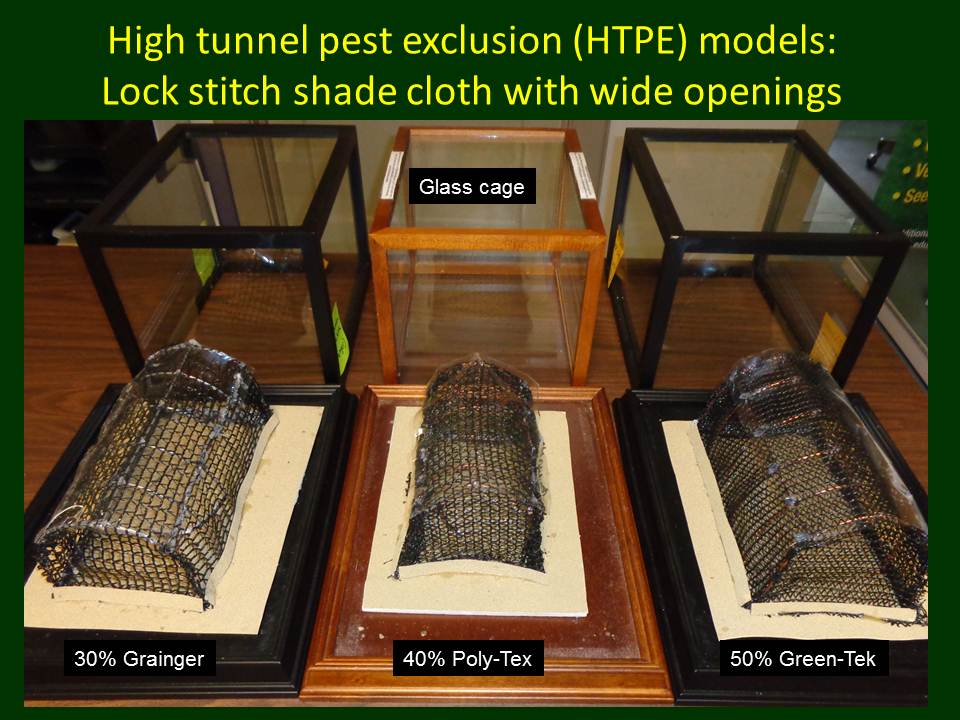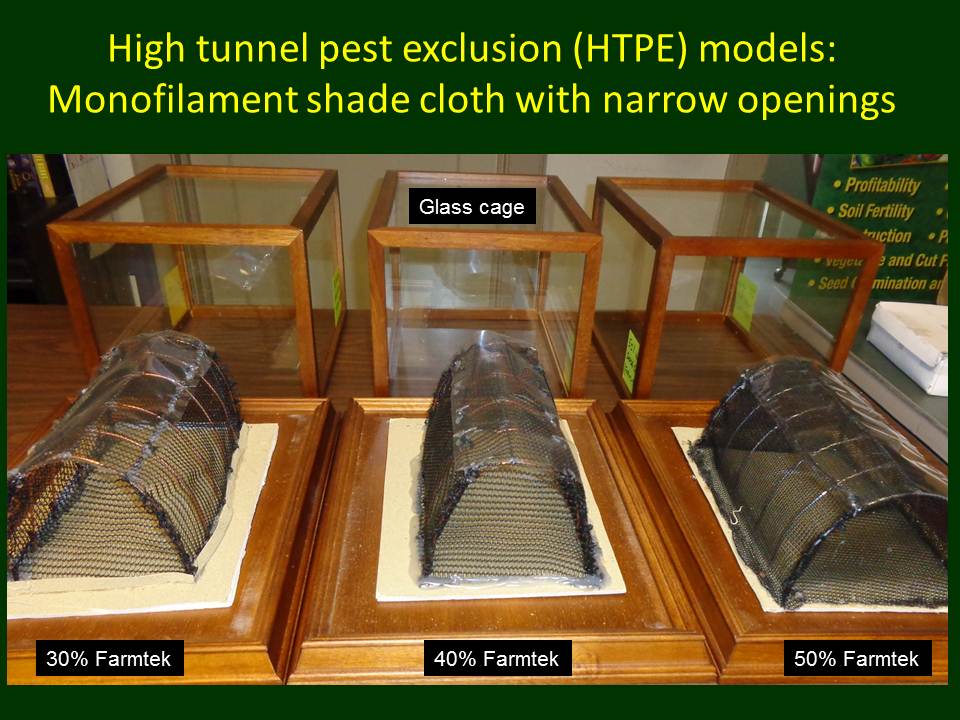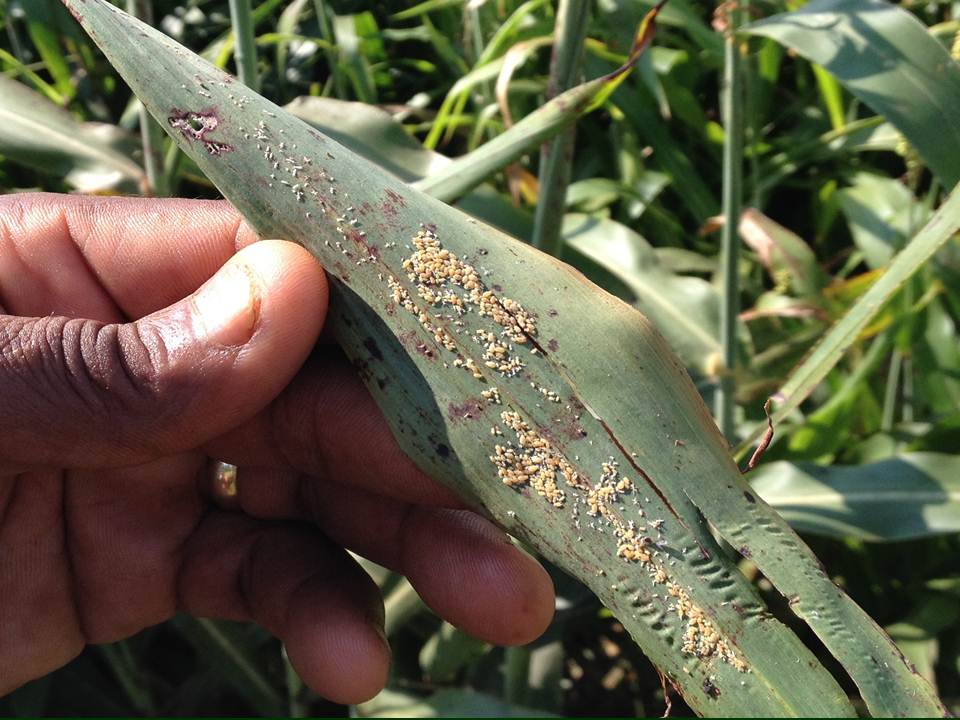Journal of the NACAA
ISSN 2158-9429
Volume 9, Issue 1 - June, 2016
Effect of High Tunnel Pest Exclusion System on Two Natural Enemies
- Majumdar, A., Extension Specialist, Alabama Cooperative Extension System
Chambliss, A., IPM Program Associate, Alabama Cooperative Extension System
ABSTRACT
Earlier papers by this author demonstrated the usefulness of the high tunnel pest exclusion (HTPE) system as a practical pest prevention strategy for vegetable producers. However, possible impact of HTPE on natural enemies was not evaluated. Therefore, detailed laboratory studies were conducted to test the behavior of lady beetle and lacewing adults using HTPE models. Laboratory tests indicated natural enemy exclusion to be strongly dependent on exclusion material and host availability (prey insects). Based on current findings, the 40 or 50% shade cloth with wide openings appear to be the most adequate pest exclusion materials with minimum side effects.
Introduction
Alabama has a rapidly growing vegetable production industry fueled by the increasing population and demands for local foods. Major vegetable crops include tomato, cucurbits, sweet corn, and leafy greens. High tunnel crop production has become very popular in the state due to the possibility of early crop production and intensive cultivation of multiple crops in a small area. However, one of the major limiting factors of vegetable production in the Deep South is the over-abundance of insect pests. Yield losses may occur rapidly due to direct feeding on fruits resulting in the poor marketability of produce.
Caterpillars and leaffooted bugs have become the largest obstacles to organic crop production inside high tunnels. Multiple generations of caterpillars can devastate tomato and other summer crops causing 50% or more yield loss (Majumdar, et al., 2014). Leaffooted bugs, with their sucking mouthparts and unique aggregation behavior, are currently the #1 pest problem mentioned by producers in Extension surveys conducted by authors (Majumdar, unpublished data) simply because none of the organic-approved insecticides are effective. Even though there are effective conventional insecticides against leaffooted bugs for open field crop, high tunnel producers may not be able to use them in protected structures. Thus, pest prevention becomes more important than therapeutic control measures.
USDA National Organic Program recommends a three-tiered approach to pest management. Pest exclusion is recommended as the second approach to pest reduction. Pest exclusion has been studied in many parts of the world as an economical and viable option for pest management (Martin et al., 2006; Saalau et al., 2011). Alabama Extension’s ‘Organic and Small Farm Training Program’ has been evaluating and demonstrating the benefits of pest exclusion systems since 2011 due to increasing demand for IPM information from organic vegetable producers (Majumdar and Powell, 2011).
Majumdar et al. (2015) proposed the basic aspects of the high tunnel pest exclusion (HTPE) system to be effective design and appropriate material for long-term success. The HTPE system proposes the use of a 40 or a 50% knitted shade cloth installed under the side-wall plastic as a permanent pest exclusion system to stop insect pests such as armyworms, hornworms, leaffooted bugs and stink bugs (i.e., very mobile adults). While the HTPE system has already provided major benefits to some key producers in Alabama, a major concern was the possible exclusion of natural enemies (Majumdar and Mastin, 2015). Current paper describes detailed laboratory-based behavioral studies (using special models or arenas) to assess the movement of lady beetles and lacewings across shade cloths of varying grades. This research is important since an ideal HTPE system should not exclude all natural enemies that are important to manage small insects like aphids and whiteflies inside the high tunnels. To our knowledge, this is the first laboratory study of beneficial insects and aphids inside high tunnel models. The implications of our laboratory findings and on-going field demonstrations with key producers are discussed at the end of this paper.
Laboratory Methodology
HTPE model material and construction: Majumdar et al. (2015) describe the construction of HTPE test models or arenas using locally-available materials. The high tunnel models had an opening in the bottom to introduce host (prey); the bottom was taped shut to prevent the entry of beneficial insects. We purchased shade cloth samples from various vendors (listed below) and wrapped them around the side-walls of six models to form a tight fit. The control arena was simply a high tunnel model without the netted side-walls. All models were housed in individual 15 inch x 8inch glass display cases. For this study, we used two different types of fabric as follows:
a. Lock stitch knitted fabric with wide openings (Figure 1): 30% shade cloth from Grainger (Lake Forest, IL), 40% shade cloth from Poly-Tex (Castle Rock, MN), and 50% from Green-Tek (Janesville, WI)
b. Knitted monofilament fabric with small openings (Figure 2): 30, 40 or 50% shade cloth manufactured by Farmtek (Dyersville, IA)
Figure 1. High tunnel pest exclusion models with 30, 40 or 50% shade cloth with lock stitch weaving pattern. There was an opening at the bottom for introducing aphids.

Figure 2. High tunnel pest exclusion models with 30 to 50% monofilament shade cloth with narrow openings. Bottom of the models had opening for introducing aphids.

Insect behavior studies: We collected sugarcane aphids (Melanaphis sacchari) from sorghum fields in Clanton (Central Alabama). Sugarcane aphid have been found in many states (Seiter et al., 2014) and it forms large colonies under sorghum leaves (Figure 3). Sorghum leaf discs (2 inch diameter) containing about 200 aphids were introduced inside the HTPE model from the bottom opening. We purchased commercially-available convergent lady beetles (Hippodamia convergens) and green lacewing adults (Chrysoperla spp.) for replicated studies. Beneficial insects were bought from Arbico Organics (Oro Valley, AZ) and tested within three days of delivery. Twenty active adults were released under the glass cages outside the model and left undisturbed for 8, 24 or 48 hours. All tests were repeated three times. ANOVA was conducted using SPSS v.23 and means were separated using Duncan test at 0.05 significance level.
Figure 3. Sugarcane aphid (Melanaphis sacchari) colonies under sorghum leaves, Clanton, AL. Due to the abundance of this species, it was used in HTPE studies with natural enemies.

Results
This was a challenging study since we had to synchronize field collected sugarcane aphids with commercially-purchased lady beetles and lacewings for all the tests. Sugarcane aphids were abundant in sorghum fields at Clanton and were very attractive to the lady beetles and lacewings (AM, personal observation). Preliminary results from HTPE laboratory tests are summarized in Table 1 where the numbers indicate percent lady beetles or green lacewings that moved into the model after release in the cages.
Lady beetle behavior: The monofilament shade cloth from Farmtek slowed down lady beetle entry into the models; the effect was most noticeable with a 50% fabric due to very narrow openings (Figure 2). This contrasts with the 50% knitted shade cloth from Green-Tek that allowed 32% lady beetle migration after 24 hour of release. Sugarcane aphids had a large impact on lady beetle behavior. Presence of aphids inside the tunnels increased lady beetle movement by 10 to 40 percent which is a relevant finding. The shade cloth with wide openings (sourced from Grainger, Poly-Tex, and Green-Tek) allowed lady beetles to move in and out of the models. Due to excessive dispersal of aphids, laboratory studies were discontinued after 24 hours.
Green lacewing behavior: Lacewings have a larger wingspan compared to the lady beetles; this was detrimental to their migration across shade cloths. Presence of aphid colonies inside the HTPE models greatly increased the movement of lacewings through all materials, except the 40 and 50% monofilament (fine openings). The 50% fine netting completely excluded green lacewings which is an important finding. Due to excessive dispersal of aphids inside the models, the studies were discontinued after 24 hours.
Table 1. Movement of beneficial insects at 8, 24, or 48 h post-release (20 insects released per test). Numbers indicate percent lady beetle or lacewing adults that migrated into the high tunnel models.
|
|
|
|
Lady beetle migration with sugarcane aphids inside the models |
|
||||||||
|
|
|
|
Lock stitch shade cloth with wide openings |
|
Monofilament shade cloth with small openings |
|||||||
|
Observation times (hours after release) |
Control (non-netted model) |
|
30% Grainger |
40% Poly-Tex |
50% Green-Tek |
|
30% Farmtek |
40% Farmtek |
50% Farmtek |
|||
|
8 h |
0 |
|
43 |
35 |
18 |
|
32 |
5 |
0 |
|||
|
24 h |
0 |
|
52 |
35 |
32 |
|
50 |
42 |
8 |
|||
|
48 h* |
- |
|
- |
- |
- |
|
- |
- |
- |
|||
|
|
|
|
|
|
|
|
|
|
|
|||
|
|
|
|
Lady beetle migration without aphids |
|
||||||||
|
|
Control (non-netted model) |
|
30% Grainger |
40% Poly-Tex |
50% Green-Tek |
|
30% Farmtek |
40% Farmtek |
50% Farmtek |
|
||
|
8 hours |
0 |
|
0 |
0 |
0 |
|
0 |
0 |
0 |
|
||
|
24 hours |
5 |
|
5 |
5 |
0 |
|
5 |
0 |
0 |
|
||
|
48 hours |
5 |
|
5 |
5 |
0 |
|
5 |
0 |
0 |
|
||
|
|
|
|
|
|
||||||||
|
|
|
|
Green lacewing migration with sugarcane aphids inside the models |
|
||||||||
|
|
Control (non-netted model) |
|
30% Grainger |
40% Poly-Tex |
50% Green-Tek |
|
30% Farmtek |
40% Farmtek |
50% Farmtek |
|
||
|
8 hours |
17 |
|
23 |
7 |
8 |
|
12 |
2 |
0 |
|
||
|
24 hours |
20 |
|
28 |
15 |
8 |
|
13 |
5 |
0 |
|
||
|
48 hours* |
- |
|
- |
- |
- |
|
- |
- |
- |
|
||
|
|
|
|
|
|
||||||||
|
|
|
|
Green lacewing migration without aphids |
|
||||||||
|
|
Control (non-netted model) |
|
30% Grainger |
40% Poly-Tex |
50% Green-Tek |
|
30% Farmtek |
40% Farmtek |
50% Farmtek |
|
||
|
8 hours |
25 |
|
0 |
0 |
0 |
|
0 |
0 |
0 |
|
||
|
24 hours |
15 |
|
0 |
0 |
0 |
|
10 |
0 |
0 |
|
||
|
48 hours |
15 |
|
0 |
0 |
0 |
|
10 |
0 |
0 |
|
||
Overall findings: Table 2 provides average number of natural enemies (lady beetles and lacewings) that migrated across the exclusion material to feed on aphids. Results at 8 hour and 24 hour post-release were highly significant for all tests. The 50% Farmtek shade cloth (small opening) significantly reduced natural enemy movement compared to the 30 or 40% shade cloth manufactured by Grainger or Poly-Tex.
Table 2. Migration of lady beetle and lacewing adults in response to aphid (prey). Number indicate average number of natural enemies that crossed the exclusion treatments. Treatments with the same letters are not significantly different from each other.
|
Exclusion treatment (shade cloth) |
Netting type |
|
Lady beetle migration with sugarcane aphids inside model (Mean ±Std. Dev.) |
|
Lacewing migration with sugarcane aphids inside model (Mean ±Std. Dev.) |
||
|
|
|
|
8 hour post-release |
24 hour post-release |
|
8 hour post-release |
24 hour post-release |
|
|
|
|
|
|
|
|
|
|
Untreated check |
No netting |
|
0.0 ± 0.0a |
0.0 ± 0.0a |
|
3.3 ± 1.5cd |
4.0 ± 1.0cd |
|
|
|
|
|
|
|
|
|
|
30% Farmtek |
Small opening |
|
6.3 ± 1.2bc |
10.0 ± 1.0c |
|
2.3 ± 2.1bc |
2.7 ± 0.6bc |
|
|
|
|
|
|
|
|
|
|
30% Grainger |
Wide opening |
|
8.7 ± 0.6c |
10.3 ± 1.2c |
|
4.7 ± 0.6d |
5.7 ± 2.1d |
|
|
|
|
|
|
|
|
|
|
40% Farmtek |
Small opening |
|
1.0 ± 1.0a |
8.3 ± 2.1bc |
|
0.3 ± 0.6ab |
1.0 ± 1.0ab |
|
|
|
|
|
|
|
|
|
|
40% Poly-Tex |
Wide opening |
|
7.0 ± 2.0c |
7.0 ± 0.0bc |
|
1.3 ± 1.2abc |
3.0 ± 1.0bc |
|
|
|
|
|
|
|
|
|
|
50% Farmtek |
Small opening |
|
0.0 ± 0.0a |
1.7 ± 0.6a |
|
0.0 ± 0.0a |
0.0 ± 0.0a |
|
|
|
|
|
|
|
|
|
|
50% Green-Tek |
Wide opening |
|
3.7 ± 4.0ab |
6.3 ± 4.0b |
|
1.7 ± 0.6abc |
1.7 ± 1.1ab |
|
|
|
|
|
|
|
|
|
|
|
F |
|
5.74 |
14.36 |
|
6.34 |
8.44 |
|
|
Sig. |
|
0.003** |
0.000*** |
|
0.002** |
0.001** |
Discussion
Previous studies have provided valuable information about the effectiveness of a HTPE system for excluding large insect pests like moths and leaffooted bugs. The current study provided valuable information about natural enemy behavior moderated by the presence of exclusion material (30, 40 or 50% shade cloth) and host insect (sugarcane aphid). There is strong evidence regarding the limitations of a 50% fine mesh fabric that can significantly reduce or completely exclude lady beetles and lacewings; in the real world, this can lead to an outbreak of aphids on crops grown with the HTPE system. Based on our preliminary studies, it appears that a 30, 40, or 50% knitted shade cloth with wide openings will allow natural enemy migration which is desirable. Majumdar et al. (2015) demonstrated that the 30% fabric from Grainger was too wide for stopping leaffooted bugs; only a 40 or 50% knitted shade cloth from Poly-Tex or Green-Tek appear to be the most effective bug exclusion materials that may cause minimum side-effects (i.e., natural enemy exclusion). However, HTPE system also opens the door for using commercially available natural enemies as inundative releases inside the netted structures to manage small insect pests.
A tight seal of the fabric around the side- and end-walls is critical to the success of the HTPE system. Field assessment of the HTPE system is ongoing across several locations in Alabama. Producer Will Mastin from South Alabama has observed a reduction in lady beetle numbers with 50% monofilament shade cloth that match our findings. Readers should contact Extension service in their state for correct insect identification and additional resources for a site-specific IPM plan. Please consult the author for more information about the HTPE system or visit the Alabama Vegetable IPM website for an IPM training module on this topic.
Funding
This project was funded by USDA SARE Professional Development Program (2014, 2015) and Alabama Specialty Block Grants (2013, 2015).
Acknowledgement
Alabama Extension and the Alabama Vegetable IPM Project would like to sincerely thank the support of producers and Extension Agents that have participated in this project.
References Cited
Majumdar, A., and M. Powell (2011). Net house vegetable production: Pest management successes and challenges. Journal of the NACAA. Vol. 4 (1). [Online] http://www.nacaa.com/journal/index.php?jid=87.
Majumdar, A., A. Caylor, and J. Pitts (2014). Late-season caterpillar control in tomatoes using bioinsecticide premixes ad tank-mixes. Arthropod Management Tests. Vol. 39.
Majumdar, A., A. Chambliss, W. Mastin, and S. Carpenter (2015). High tunnel pest exclusion system: Laboratory and field experiences. Journal of the NACAA. Vol. 8 (1). http://www.nacaa.com/journal/index.php?jid=487.
Majumdar, A., and W. Mastin (2015). High tunnel pest exclusion system: A novel strategy for organic crop production in the South. Southern SARE Bulletin. [Online] http://www.southernsare.org/Educational-Resources/Bulletins/Southern-SARE-Bulletins/High-Tunnel-Pest-Exclusion-System-A-novel-strategy-for-organic-crop-production-in-the-South.
Martin, T., F. Assogba-komlan, T. Houndete, J.M. Hougard, and F. Chandre (2006). Efficacy of mosquito netting for sustainable small holder’s cabbage production in Africa. Journal of Economic Entomology. 99: 450-454.
Saalau, E., M. Gleason, and J. Batzer (2011). Can row covers stop cucurbit bacterial wilt, and are they cost effective? Horticulture and Home Pest News, Iowa State University Extension and Outreach. [Online] http://www.ipm.iastate.edu/ipm/hortnews/2011/2-9/rowcover.html.
Seiter, N., G. Lorenz, G. Studebaker, and J. Kelley (2014). Sugarcane aphid, a new pest of grain sorghum in Arkansas. University of Arkansas Research and Extension System, Bulletin FSA7087. [Online] https://www.uaex.edu/publications/FSA-7087.pdf.
USDA National Organic Program. [Online] http://www.ams.usda.gov/AMSv1.0/nop.
HTPE training module
Pest exclustion training module, Alabama Vegetable IPM Program: http://www.aces.edu/anr/ipm/Vegetable/pestexclusion.php.
